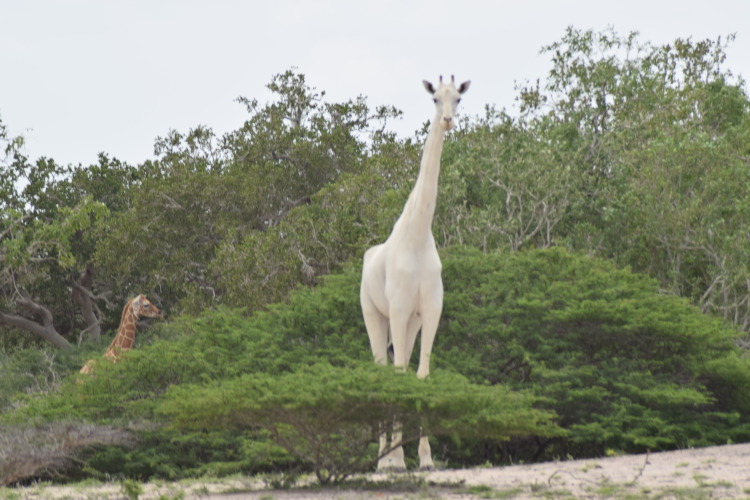Early june this year, reports of a white baby giraffe and its mother were reported to us by the rangers who got the report from one of the villagers adjacent to the Ishaqbini conservancy. We hurriedly headed to the scene as soon as we got the news. And lo! There, right infront of us, was the so hyped ‘white giraffe’ of Ishaqbini conservancy! They were so close and extremely calm and seemed not disturbed by our presence. The mother kept pacing back and forth a few yards infront of us while signalling the baby Giraffe to hide behind the bushes – a characteristic of most wildlife mothers in the wild to prevent the predation of their young.
While observing the magnificent long necked animal looking at us, I could not but help see the fading reticulates on their skin! It was evident that the coloration especially on the mother giraffe was not as conspicuous as the baby. The question that lingered in my mind was if the fading on the skin was something that happened at birth or thereafter in the adult giraffe life? This is because the baby giraffe, had very conspicuous reticulates but with a small tinge of the white coloration that seemed to continue fading away leaving the baby white as it approaches adulthood.


White giraffe sightings or leucistic giraffe as they are better known have become more frequent and common nowadays. In fact, the only two known sightings have been made in Kenya and Tanzania. The very first reports of a white giraffe in the wild was reported in January 2016 in Tarangire National park, Tanzania; a second sighting was again reported in March 2016 in Ishaqbini conservancy, Garissa county, Kenya.
As a matter of fact, these sightings have become a common occurrence in the hirola’s geographic range that the communities in these areas (especially within our conservancies) have become so excited to a point where everybody has been participating in reporting the sighting of these magnificent animals! But the question that lingers in the minds of many is, is the giraffe white or what’s up with its coloration? Experts have explained that the condition is known as leucism, which results in the partial loss of the pigmentation of the giraffes original color. In this very sighting, in Ishaqbini, there was a mother and a juvenile The communities within Ishaqbini have mixed reactions to the sighting of this leucistic giraffe and most of the elders report that they have never seen this before. ‘This is new to us” says bashir one of the community rangers who alerted us when they sighted the white giraffe. “I remember when I was a kid, we never saw them” he added. “It must be very recent and we are not sure what is causing it” he said.
As excited as the locals, Hirola Conservation Programme Director & Founder, Dr. Abdullahi Ali says, “Nature is always stunning and continue to surprise humanity! These rare snow white giraffes shocked many locals including myself but these gave us renewed energy to protect and save our unique wildlife. I am positive these rare giraffes will change the perception of outsiders regarding north eastern Kenya in which many people have negative perceptions. I remember two years while I was in the US someone asked me where do you come from in Kenya and I said Garissa in Eastern Kenya. Her immediate response was that “there is a lot of nothing there”. Snowy white giraffes and the rare hirola are off course not everywhere! In this regard and in partnership with local communities, relevant authorities in Kenya and international partners, we promise to protect these beauties and their vital habitat. We are also curious to know the daily whereabouts of these giraffes, so we will keep an eye on them.”


Wow, this is exciting. I will add this to my bucket list to visit Kenya and Tanzania. I have visited Kenya parks in the past.